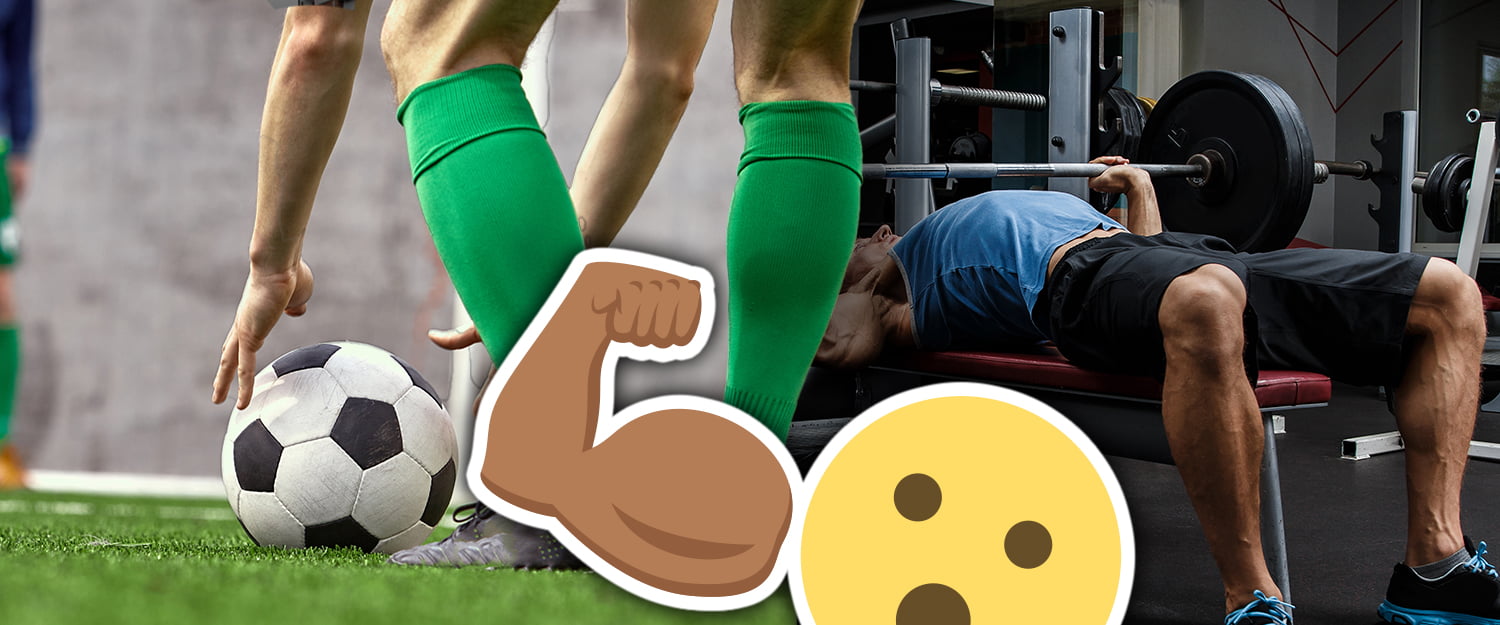How Much Do Footballers Lift? – Full Guide
Footballers are obviously in good shape, but they tend to be slim and athletic in comparison to NFL or rugby players. Despite this, football players put in a lot of time in the gym, and the best have incredible strength and athleticism.
All footballers have different physical strengths, which are usually determined by their position on the field. So, how much do football players lift, and how does it affect their game?
Key Takeaways
| Aspects | Details |
|---|---|
| Importance of Strength Training | Enhances performance, prevents injuries, boosts endurance. |
| Factors Influencing Lifting | Genetics, position, age, experience, and training regimen play a role. |
| Average Lifting Capacity | Varies by position; significant differences across leagues and countries. |
| Case Studies | Profiles of famous footballers highlight the impact of strength training. |
| Balancing Training | Integration of strength and skill development is essential. |
| Myths and Misconceptions | Evidence-based clarification of common false beliefs. |
Why Footballers Lift Weight
Weightlifting is an integral way in which footballers cater to and prepare their physical bodies for the necessities of soccer.
The physical requirements that weightlifting helps players achieve include improved performance, agility, endurance, and injury prevention.
1. Enhances Performance
Increased power, especially when it comes to taking shots, is linked with weight exercises that are targeted at building leg muscles.
Moreover, footballers who lift weights can experience increased muscle and joint function while playing.
This comes from the mobility range that comes from weightlifting exercises such as bench presses, dumbbell shoulder squats, and more.
2. Boost Strength And Endurance
A key benefit of lifting that soccer players enjoy is the boost in strength and endurance. These two elements are vital in prolonged sports such as football, and constant lifting expands the capacity footballers possess.
Moreover, when we talk about strengths, we are not merely insisting on the build of footballers (as in their physical muscles), but rather we talk about the amount of force the muscles can exert.
Therefore, it causes an expansion in the force exerted by the muscles and also determines how long the muscle can consistently exert this force.
3. Aids Injury Prevention And Recovery
Compound lifts are very proficient way of preventing muscle injuries, especially for athletes. This is because they focus on the entirety of the body, strengthening the groups of muscles rather than just a part.
Through lifting, players the dominant muscles in the body are exercised making them less likely to cramp or fatigue easy.
Also, in injury recovery, the muscles in the body tend to atrophy. For this reason, lifting is a good way to keep the muscles active and regain its original form as it recovers.
4. Maintains Body Muscle To Fat Composition
Part of being a professional soccer player is the need to maintain an healthy and athletic physique. Therefore, whenever footballers gain excess body fat, lift exercises are an efficient way to lose them.
In addidition, this balance in body fat and body muscles goes a long way in ensuring their on field performance.
Factors That Determine How Much Footballers Lift
1. Genetics And Body Type
Genes and body type largely influence how much players go to the gym. Some players who do not have the
2. Position-specific Requirement
Central defenders are typically taller and have larger frames than most players, which is how players end up becoming defenders and specializing in these positions. Smaller players are better suited to positions requiring less strength, such as full backs and wingers.
As a result, different players lift in different ways and can lift different amounts depending on their role. There are, however, elements of strength that all players require. This is core strength, which aids agility, balance, and the ability to outrun defenders when running at high speeds. Lower body and leg strength are also important for muscular endurance, explosive acceleration, and kicking.
3. Age And Experience
What is the Average Lift Capacity Of Football Players?
How Much is too Much Lifting?
First and foremost, lifting the most weight does not make footballers the best. For example, the game’s strongest professional player is probably Adebayo Akinfenwa, who plays for Wycombe Wanderers in the Championship but has spent the majority of his career in English Leagues 1 and 2. The striker, dubbed “the Beast,” is said to be able to bench press over 300 pounds for 20 reps.
Akinfenwa is a one-of-a-kind player who contributes to his team in an unconventional way. His size is unrivaled, so defenders can’t get near him when he has the ball, and he can win almost every aerial duel by shifting the opponent out of the way.
These are useful skills for a striker, but his size would be ineffective in other positions. The mobility required for a central midfielder would be excessive, and his size means his pace is sacrificed, making operating in wide areas of the pitch difficult.
How Footballers Lift
Lifting is something that football players can do in a variety of ways. During the season, players and teams will usually only go to the gym two to three times per week to reinforce the strength and endurance they’ve built in the off-season.
That means low-weight workouts of 8-10 reps, no more than an hour and a half in the gym, and movements that are complex (working multiple joints at once) but not too high-impact. The majority of these sessions would focus on the lower body and would include exercises such as squats, lunges, weighted sled drags, step-ups, and resistance band exercises.
Players will most likely increase their intensity during the off-season in order to improve their stamina, speed, and power. These training plans will have them in the gym 4-5 times per week, lifting heavy weights for 6-8 reps and doing a lot of complex, high-impact work. Players who want to build muscle will increase their lifting by using heavier weights for fewer repetitions.
Players sometimes return to the new season looking completely different – bigger and bulkier. This is because this type of exercise is best done during the off-season. Footballers do not lift bulk up during the season because it is unlikely to improve their performance.
Case Study Of Footballers Who Lift Weight
Which Footballers Lift to Get Bigger?
Some players want to bulk up and get bigger, so they lift heavier weights for fewer repetitions. Lifting as much weight as possible helps to build muscle and make players bigger. Goalkeepers, center-backs, and possibly strikers are examples of players who may want to do this. A strong physical presence is required for goalkeepers.
This is especially important when coming for crosses and corners and catching the ball up against opponents going for headers. Center-backs benefit from a strong physique in order to outpower strikers and win headers. Strong strikers can go up against these defenders with strength, but it depends on the player’s style, as strikers can use speed or skill.
David De Gea
Many criticized David de Gea’s very skinny frame when he first arrived in the Premier League, saying it made him vulnerable and unable to command the penalty area. De Gea returned from his first season looking much bigger, and his form improved dramatically.
Joe Gomez
Joe Gomez is another case in point. As a teenager, the young Liverpool center-back joined the club. He had the physique of a slightly slim center-back, but Gomez began the Premier League last season looking much stronger, particularly in his upper body. This meant he looked similar to his colossal center-back partner, Virgil Van Dijk.
FC Bayern Munchen Squad
Many people have been surprised by how much Bayern Munich players have beefed up in the last year. There have been numerous online transformation pictures of a number of their players who used to cut slender, trim figures but are now absolutely ripped. Leon Goretzka and Phillipe Coutinho, in particular, are midfielders who have always had slim physiques despite being excellent players.
They have, however, become very muscular and bulked up significantly. Goretzka was once a lanky midfielder, but his height has transformed him into a midfield powerhouse. The muscle growth does not appear to have affected their speed, as the team appears sharper and more intense than ever, as evidenced by their Champions League victory in 2020.
Cristiano Ronaldo
Cristiano Ronaldo is a footballer who is frequently mentioned when discussing their gym efforts. As a child, Ronaldo was told that he was too small and slender. He certainly demonstrated that hard work could yield incredible results. There is no doubt that Ronaldo has dedicated his life to becoming an exceptional athlete.
The pull-up burpee, which works a variety of muscle groups in one exercise, is one of his favorites. The majority of Ronaldo’s gym work consists of endurance and high-intensity exercises designed to improve cardiovascular fitness as well as muscular endurance. He does, however, continue to lift weights.
Ronaldo prefers heavy weights with many reps to heavier weights with fewer reps in order to maintain his agility and stay lean while remaining muscular and strong. He lifts a lot of weights in a gym session to work all muscle groups. He has been reported to lift around 23,000kg per gym session.

Footballers Who Don’t Lift
While Cristiano Ronaldo is an example of an extremely professional athlete who spends a significant amount of time in the gym working on his body, not all players can say the same. Some footballers simply enjoy playing the game, and the only training they want to do is on the field, whereas others are naturally gifted with strong physiques that require only a healthy and active lifestyle to stay ripped.
Adama Traore
The latter is true of Adama Traore. The Wolves winger underwent a massive body transformation, going from an average-sized midfielder in the Championship to a bulky player more resembling a rugby winger or an NFL player.
Many people were curious about his gym routine and whether the Wolves’ medical team had designed a program for him to achieve this weight and physique.
However, the player stated that he never lifted weights. This is difficult to believe, but Traore claims it is simply genetic. He works hard in the gym and does the necessary work, which for footballers is primarily resistance work and high-intensity lower body workouts, but Traore simply gains muscle mass very quickly and easily.
Brede Hangeland’s ‘Lazy XI’
Brede Hangeland, a former Fulham defender, once revealed his ‘Lazy XI,’ in which he called out his former teammates for never going to the gym. Wilfried Zaha, the incredibly athletic and skilful winger who Hangeland claimed ‘did 5 press ups in the gym and left,’ was among those players.
Dimitar Berbatov was another name. Even when he’s on the field, the striker is known for getting massages while his teammates lift weights.
Wayne Rooney
Many other players, including Wayne Rooney, would be uninterested in going to the gym. Rooney works so hard on the field that you’d think he’d work just as hard in the gym, especially as a fairly bulky player.
However, it was his love of the sport that most likely led to his dislike of the gym. He wanted to play football every day in training, and, in hs opinion, anything that didn’t involve playing football was pointless when preparing for a football match. Maybe you’re right!
How Much Should Footballers Lift Weight?
Common Misconceptions Of Lifting Weights When it Comes To Soccer Players
Conclusion
Overall, football players lift weights throughout the season, but not usually with the goal of bulking up. This is important for some players, and they frequently build muscle on their own during the off-season.
Top clubs’ training staff would prefer that gym exercises reflect the muscles needed for football and that training exercises incorporate movement and focus on lower-body endurance.








